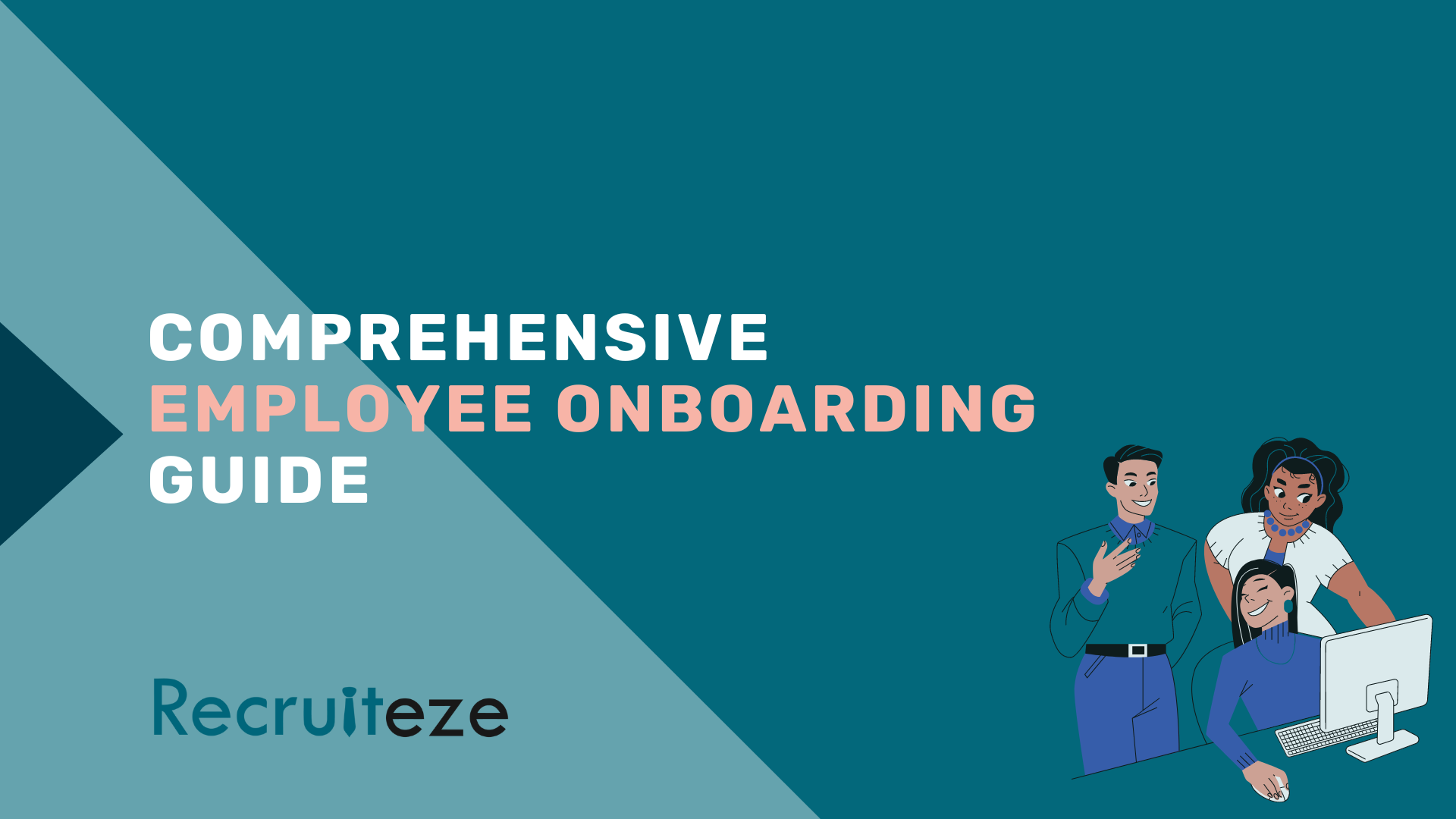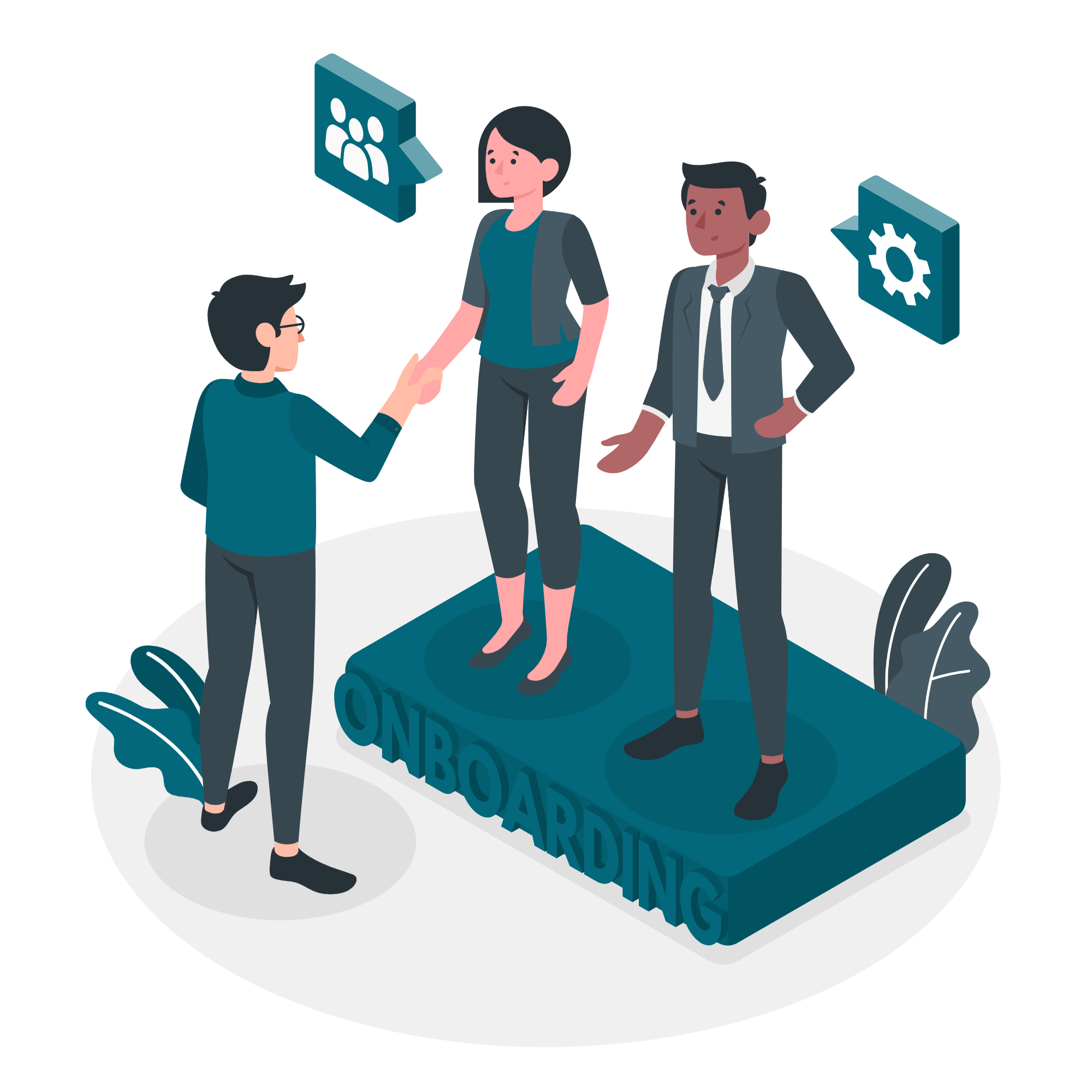
Employee onboarding is a massively important stage in the recruitment process, but it’s often relegated to an afterthought. At its worst, employee onboarding isn’t done at all.
Even if you don’t completely neglect it there’s a good chance you’re doing it wrong.
Too many employee onboarding programs aren’t inclusive, transparent, or open, and they don’t encourage the two-way sharing of insight. Your employee onboarding program isn’t just an opportunity to hand over the computer. It’s an important opportunity to reinforce who you are, and how your new employees fit into that.
This is especially a huge problem now with remote working where no one has to go to the office and you all rely on Slack, Asana, Zoom, and other digital workspaces.
And this is exactly why we sat down and crafted this employee onboarding guide: to help companies do it the right way. In this guide, we will go over:
- Intro: 7 Reasons why employee onboarding can’t and must not be ignored
- Cost-efficiency
- Shorter time to productivity
- Elevating the employer brand
- Reducing costly mistakes down the line
- Encouraging transparent communication
- Get important feedback to improve brand perception
- Bolster performance across your organization
- Top 7 practical employee onboarding tips
- 0 – Finding the right fit
- Starting before the first day
- Make the right introductions
- Share the unwritten rules
- Make sure they know the rules of play
- Think about the little details
- Give them a warm welcome
- Introduce them to your social scene
- The best employee onboarding software
Without further ado, let’s start!
Want to simplify and optimize your employee onboarding processes? Then you should test out our new product, HReze!
HReze helps you reduce the stress and hassle that comes with employee onboarding and management processes. The software allows you to stay organized, be more time-effective and focus on what truly matters. Impressing your new employees.
Sign up for the beta here and become a part of Recruiteze ecosystem.
What is employee onboarding?
Employee onboarding is the process of integrating a new employee into an organization and its culture. It’s also a key time for providing a new hire with the necessary tools, information, skills, and behaviors expected in their role.
A successful onboarding program goes beyond just an orientation day or week—it can extend over several months, and ideally, it will lay the groundwork for long-term engagement and productivity.
Components of an effective onboarding process can include:
- Preparation before the first day: This can involve setting up the new employee’s workspace, providing necessary equipment, and ensuring their access to relevant systems and software.
- Orientation: This usually involves introducing the new employee to their colleagues, explaining the company’s policies and culture, giving a tour of the workplace, and outlining the expectations and responsibilities of their role.
- Training and development: Depending on the role, the new hire may need specific training or coaching. This might be delivered through formal training sessions, e-learning, or on-the-job training.
- Mentorship: Assigning a mentor or a buddy to a new employee can help them settle in more quickly. This person can answer questions, offer advice, and provide social support.
- Follow-up and feedback: Regular check-ins during the initial months can help address any issues or concerns, and provide an opportunity for constructive feedback.
An effective onboarding process can significantly contribute to an employee’s satisfaction, productivity, and long-term retention. It can also help new hires to quickly become effective and integral members of the organization.
Intro: 7 Reasons Why Employee Onboarding Can’t and Must Not Be Ignored

Go back to your first day at work.
Now go back even further to your first day at school.
The emotions are pretty similar, right?
One part excited, one part nervous about doing a good job, one part terrified everyone will hate you. As HR professionals it’s our job to take that melting pot of emotions and make sure they leave after day 1 feeling elated, engaged, and inspired.
Done right, an effective employee onboarding program is a chance to build and reinforce your brand. It sets the tone for your future relationship with that employee. It has a huge role to play in how productive and engaged they go on to be.
Employee onboarding helps improve your retention rates and lower your recruitment costs, and it helps you embed the culture you aspire to.
In all, your employee onboarding process has a huge effect on your business bottom line. If you aspire to be a more successful, forward-thinking, growth-oriented company, you can’t afford to ignore employee onboarding.
Here’s why you should care about exceptional candidate onboarding.
Cost-efficiency

It’s fair to say that turnover is expensive. It costs tens of thousands of dollars to attract, find and hire talent. Those costs can run into the hundreds of thousands for mid and senior-level candidates too.
Plus, you’ve got the more intangible costs that turnover causes. Loss of morale, decreased productivity, cultural erosion. The list goes on.
In all, it’s more cost-effective to keep the talent you have, and much less of a headache too. That’s where employee onboarding comes in. There are several important ways to improve employee retention, and employee onboarding is a critical element.
Your employee onboarding experience helps ensure your people stay. It’s about setting culture. We all know how important it is to manage expectations within the recruitment process, which shouldn’t stop at onboarding.
If you don’t manage expectations early on, your employees will have their own expectations. If you don’t meet them, they’ll be dissatisfied. That whole cycle can be resolved by a good onboarding process designed to clarify your culture and processes.
Shorter time-to-productivity

Known as time-to-productivity, this is a critical metric for all HR professionals to pay attention to. Although different people define this differently (what is productivity, and when do we say we’ve arrived), the principle is important.
How quickly after hiring them are your new employees able to do the job you hired them for?
How quickly can you recuperate your recruitment cost outlay?
Your employee onboarding process ensures new hires can hit the ground running and quickly achieve the tasks you’ve hired them for. That’s a no-brainer because it ensures your recruitment spend delivers ROI more quickly.
Elevating the employer brand
As mentioned, an effective employee onboarding process has a massive part to play in forming and reinforcing your employer brand. It’s an opportunity to tell new hires who you are and why you do what you do, so they can start to leave and breathe your values.
That sounds simplistic, but in reality, this process starts much earlier – it’s vital to hire the right people to begin with.
Once you’ve hired the right people, though, your job is far from over. Culture only thrives when everyone within that culture is an advocate for it. Your employees have to understand your culture to strengthen it. That process starts with your employee onboarding process.
Get it right, and you’re well on your way to building a solid culture that your employees buy into and engage with. Happy and engaged employees make for a stronger employer brand, and a stronger employer brand is the best tool in your recruiting toolbox.
Employer brand gives you a strong ‘pull’ presence in the market, making it easier to attract top talent. When top talent is much in demand, that’s a significant benefit and can massively reduce your recruitment costs.
If your company needs more help with employee onboarding processes, then make sure to test out the beta version of our upcoming software: HReze!
Reducing costly mistakes down the line

Some mistakes fly under the radar, but others can have a huge, huge impact. For example, a simple food safety mistake within fast-food giant Chipotle led to an E-coli outbreak that cost the brand a 70% drop in earnings.
A moment of bad judgment in the middle echelons of VW, and you’ve got a diesel gate.
The point is this: employees make mistakes, and those mistakes cost money.
There’s nothing you can do to insure yourself against those mistakes completely, but you can go a long way in the right direction. Employee onboarding has a huge part to play here.
Not only does it establish your culture, but it also ensures new employees know your processes and have the tools they need to do a good job. In other words, a good employee onboarding experience provides against both lapses in judgment and simple errors (as far as is possible).
Additional read: 4-Day WorkWeek: Pros, Cons, and Hidden Costs 2023
Encouraging transparent communication

Your employee onboarding process shouldn’t be a lecture so much as a discussion, which sets a critical tone.
You should aspire to be an open, transparent company. An open-door policy is a great way to encourage employees to air any concerns early before they become major issues. This helps reduce turnover, allowing you to handle the problems before they spiral. It also improves engagement because everyone likes knowing they’ve got a voice.
Improve engagement, and you’re well on your way to improving productivity too, as well as strengthening your employee proposition. Plus, transparent communication aids in the breakdown of siloes, which further enhances productivity and allows your company to be more innovative and agile.
Get important feedback to improve brand perception

New employees have a unique perspective to offer because they’re at once inside and outside of your organization. They’ve got a foot in each camp if you like. They’ve decided to join, but they’re not yet embedded, so they can give neutrality of perception it would be difficult to find otherwise.
Employee onboarding is the ideal time to mine this knowledge. If you ask the right questions, you can use employee onboarding to determine how your brand is perceived and any important strengths and weaknesses.
You can then use this knowledge to refine further and improve your employer brand, which, as above, is a critical way to improve your recruitment. These insights are invaluable, and if you don’t have a good employee onboarding process, you’re not capitalizing on them.
Bolster performance across your organization

It might seem strange to say, but a good employee onboarding program isn’t just important for your new employees. Your new starters can breathe fresh life into your organization and galvanize your other employees to work with renewed passion.
That has obvious relevance if you’re hiring someone who’ll have responsibility for other people or for change management, but it’s just as relevant at every level.
A passionate, vigorous, engaged, and hard-working new hire can inspire the others around them to re-engage. They can act as your advocate in the organization, cutting any dissent off in its tracks.
However, your new hires won’t be the harbinger of more productive, more zealous employees unless you have a great employee onboarding program.
And for all these seven reasons we have listed, we will get down to how to have an effective employee onboarding process.
Here come the top 7 practical employee onboarding tips that you can take right now to enhance the process.
Top 7 Practical Employee Onboarding Tips

More likely than not, you’re one of the many companies doing employee onboarding wrong.
You have read numerous resources on how to do it right, maybe even paid for educational programs and expensive software… But nothing has seemed to work?
The new employees come, and everything seems fantastic for the first few weeks, or maybe days (if you are that unlucky), and then boom.
They become frustrated and overwhelmed with the new information, and the managers too. Eventually, they quit, and all the efforts and resources are wasted.
And you know the drill:
The communication wasn’t clear enough.
You overwhelmed them with data.
You micro-managed them too much.
You didn’t check up on them often enough.
You didn’t give them all the necessary files.
And the list goes on and on and on.
But don’t worry. It really doesn’t take much to create a flawless employee onboarding process if you have found the right match.
0. Find the right fit!

We can’t stress this enough, but if your job description was ambiguous and the interview process flawed, your employee onboarding is bound to fail too.
You simply cannot succeed if you didn’t hire the right employee. It sucks to hear it, but it’s true. We are working with dozens of HR teams and staffing companies, and often enough, the problem is not in the onboarding process but in the candidate selection itself.
This isn’t a guide in which we go over the nitty-gritty of candidate sourcing, reviewing, and interviewing, but if you feel like this might be a weak spot for your company, here are a few guides that might help:
- 10 Tips From Experts on How to Write Good Job Descriptions
- 11 Great Competency Based Interview Questions
- Complete Guide on Employment Assessments
- How to Make Unbiased Hiring Decisions
If your company needs more help with employee onboarding processes, then make sure to test out the beta version of our upcoming software: HReze!
1. Start before their first day

Effective onboarding is like an iceberg, and your new starters’ first day is only the tip of it. The onboarding process should begin as soon as your candidate accepts a position with you. The more work you put in beforehand, the more likely they can simply slot into your company when they do start.
In particular, this can really help lower your risk of candidate dropout after you’ve had an offer accepted. Candidate dropout can be an absolute nightmare.
For many people, this seems to happen repeatedly, and you don’t know why. The problem could well be that you’re not starting onboarding early enough. One of the most confusing times for a candidate is the resignation process, and if they’re good, they could well get a counteroffer.
For the savvy HR professional, this is the time you need to be right at your candidate’s side. You should be coaching them through the process and generally reminding them why they chose you in the first place.
Early onboarding also comes into its own if you’ve got a candidate with a long notice period. I worked once with a Digital Account Executive (a junior role) with a 3-month notice. That’s a long, long time and her current company spent every day of those three months trying to convince her to stay.
She might have wavered had it not been for the exceptional onboarding of the company she was joining. They invited her to monthly meetings; they asked her for Friday night drinks; she went to their Christmas party. By the time she joined, she was completely embedded in their culture – and she’s still there now, five years on.
2. Make the proper introductions

One of the most nerve-inducing elements of starting a new role is worrying you’ll say the wrong thing to the wrong person. Most new starters want to keep their head firmly below the parapet, at least as far as scandal or gossip is concerned. However, that fear can stop your new hires from speaking out, showing the initiative, or being willing to get involved.
You can combat that by ensuring your new starters know exactly who’s who and who to talk to about what. You should give your new starters a written guide to important stakeholders within the business. Then explain who each person is, what they do, who they work with, and who they report to. Introduce your new starters to those important stakeholders in person.
Your new hires should be familiar with the people who make your business tick, and those people should be familiar with your new hires. This helps minimize effort down the line, too, as your new employees can approach the relevant people for their issue, rather than always coming to HR. It also minimizes problems, because everyone knows who to be on their best behavior around!
3. Share the unwritten rules

Part of your onboarding mission is to give your new starters a taste as to your culture, particularly any “unwritten rules,”i.e.e:
- When is it appropriate to leave for lunch?
- What are the real working hours?
- Who do new hires need to impress?
- Is the open door policy really open door?
- How long do you have to respond to email before your boss assumes you’re skiving off?
If you personally aren’t able to share that sort of information, it can be helpful to assign a mentor who can. You probably can’t tell new-Sally that Tom-her-boss will totally judge her unless she’s in the office by 8, but find someone who can. That stuff is essential, even if we can’t say it is.
The same applies to office gossip while we’re at it. HR can’t spread gossip, after all, but gossip will no doubt spread. Making sure new hires are “in on the joke” is important too and will help your new employees bond more quickly.
4. Make sure they know the rules of play

Every company works slightly differently, and there are specific rules of play that are important.
It’s not about taking a “that’s how we do things around here” attitude, but new hires must know the lay of the land. What’s the “done thing” in your office? What’s the faux pas that no one wants to make?
This might be formal, like teaching new hires how meetings work or how to ask a superior for help. It might also be informal, like letting them know that Dave lost his brother last year and Samantha hates talking about family.
See point above RE: sticky subjects and HR… Often assigning a mentor is the most positive thing you can do to help stop your new hires from inadvertently putting a foot in it.
5. Think about the little details
The first day is confusing and challenging, and often new hires will keep quiet when they’ve got an issue to save face. Nobody likes to admit that they can’t find the ‘on’ button on their computer or ask for staples for the 77th time that day.
It’s easy to forget the details because it seems so apparent to you, but it’s often the small things that cause a big headache for newbies. Where to find new teabags if the tin is all out, for example, or where you store photocopy paper.
Sit down and mentally map out everything a new hire might do, and think of questions they might have. It can be beneficial to produce an indexed guide covering those details.
Don’t forget the practical details like the Internet, computer login, and door codes. Ensuring you’re well prepared shows your new hire you’re ready for them and ensures they can hit the ground running.
If your company needs more help with employee onboarding processes, then make sure to test out the beta version of our upcoming software: HReze!
6. Give them a warm welcome

You can’t overstate the importance of making someone feel that you’re glad to have them. Someone’s first day with you is one of the most important days of their life so far.
Show them you understand and that you’re thrilled to have them on board. Nothing is as quickly detrimental to employee engagement as feeling like a deflated balloon on their first day.
There are many ways you can do this.
The first and foremost is your attitude. Don’t ever make your new hires feel like an afterthought. They should be your most important priority today, and nothing should get in the way.
Get in early and make sure you’re ready to greet them warmly as soon as they arrive. If your office has a separate reception area, they’ll have to wait in first, make sure they’re expected, and greeted warmly by name.
You could also send out an announcement across the office to introduce your new hire. This is a powerful way to share your excitement, make sure everyone knows who your new hires are, and greet them throughout the day.
One really effective way to ensure a warm welcome is to give gifts. This doesn’t have to be a big thing. A company-branded mug or key ring can go a long way!
The point is to instill a sense of belonging in your new hires and show them that you’re as excited as they are to start this new chapter.
7. Introduce them to your social scene

Introducing your new hires to the workplace is one thing, but a workplace is about much more than those four walls. If possible, organize lunch out or after-work drinks for your new hire to meet their colleagues in a more informal setting.
This acts as an icebreaker and helps your new employee embed within your company and culture. Hard work might be necessary, but without a bit of play, you’ll be unlikely to get the best out of your people.
Socializing is a team-building activity, and it can be much more effective than team building in the corporate jargon sense.
According to Gallup, over half of the respondents work better and are more connected to their company if they have a best friend at work. You can kick that process into motion by initiating some sort of social gathering. Then leave them to it, so they’re not on their best behavior in front of HR.
Employee onboarding has a massive impact on the bottom line. It helps you reduce turnover, improve engagement, improve productivity, and increase morale.
It makes you wonder why many companies are still doing employee onboarding so badly. With any luck, that trend stops today.
If you follow these 7 tips, you’ll have the tools to ace your employee onboarding and keep those new hires onboard for years to come.
And for the grand finale, we will talk about the best employee onboarding software that can help you be more efficient and productive during the process of onboarding.
The Best Employee Onboarding Software

Like for everything in the digital age, there is software that can aid you through every step of recruitment, and that applies to the onboarding too.
At Recruiteze, we have spent years developing our core product, Applicant Tracing System. However, we knew that there is much more to recruiting than that.
Hence, we created iReformat, a resume reformatting tool perfectly compatible with our ATS. This made the life of our ATS users much easier since it saved them loads of time on reformatting every single resume manually.
But that wasn’t enough. All of that was great for covering:
- Applicant sourcing
- Candidate experience
- Interviewing
- Bling hiring
- Streamlining the recruitment processes
- Cutting down the costs of recruitment
And much more, but what happened after they were hired was kind of hanging in the air.
And that is how HReze was born.
We knew that we had to complete our offering. It was crucial to provide the best possible service to our users.
Just like you are working hard on improving your recruitment strategies, we diligently work on finding the best solution to ease your efforts.
Hence, if you want to join the fastest growing recruiting automation family, Recruiteze, sign up now for beta testing of HReze.
Wait, you are already using another recruitment tool? But you feel like it is not paying off? And you are contemplating switching over to something else?
Say no more, since we have tested out dozens of recruiting software and made the lists of best alternatives for each one of them:
- Workable Alternatives
- Breezy HR Alternatives
- RecruiterBox Alternatives
- JazzHR Alternatives
- SmartRecruiters Alternatives
- ZohoRecruit Alternatives
- BambooHR Alternatives
Click here if you want to test our applicant tracking software or resume reformatting software for free.
